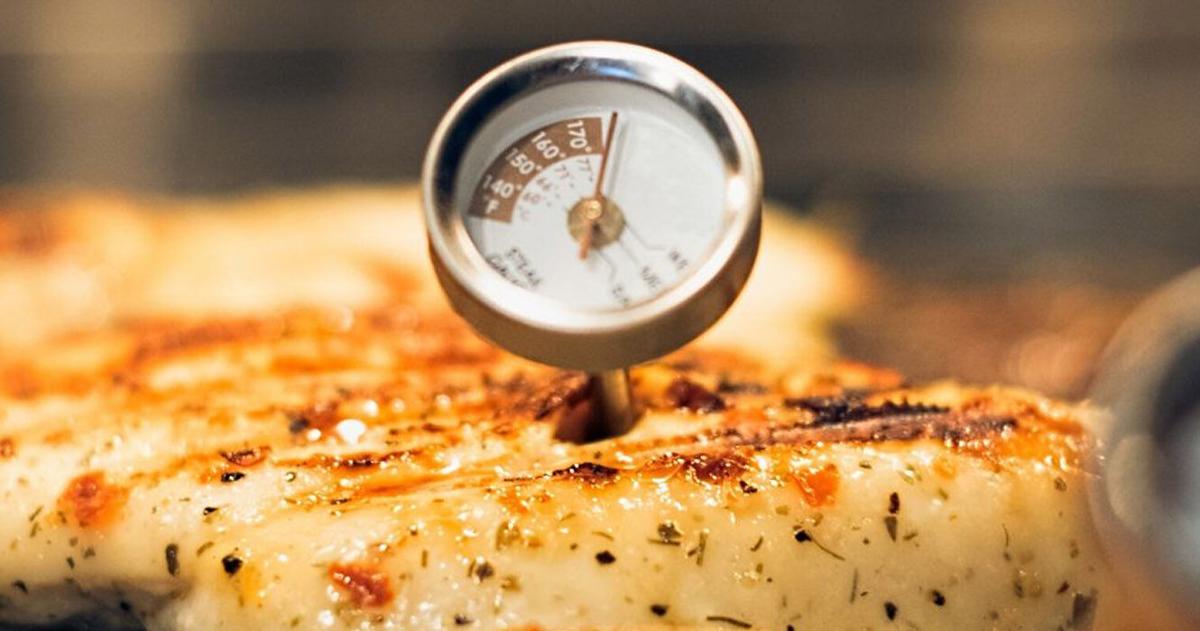If you do not have a food thermometer, you need to get one.
Many food handlers believe that visible indicators, such as color changes, can be used to determine if foods are cooked to a point where harmful germs are killed. However, recent research has shown that color and texture indicators are unreliable. Using a food thermometer does not mean that you are cooking food to a blackened, rubbery state. Food thermometers ensure safety and quality.

Cami Wells
Meat: When taking the temperature of beef, pork, or lamb roasts, the food thermometer should be placed midway in the roast, avoiding the bone. When the food being cooked is irregularly shaped, such as with a beef roast, check the temperature in several places.
Poultry: Check the internal temperature in the innermost part of the thigh and wing and the thickest part of the breast. When cooking poultry parts, insert food thermometer into the thickest area, avoiding the bone. The food thermometer may be inserted sideways if necessary. When the food is irregularly shaped, the temperature should be checked in several places.
Thin foods: When measuring the temperature of a thin food, such as a hamburger patty, pork chop, or chicken breast, the thermometer probe must be inserted in the side of the food so the entire sensing area (usually 2-3 inches) is positioned through the center of the food. Here are the temperature rules from the USDA:
Hamburgers, sausages and other ground meats should reach 160 degrees F.
All poultry should reach a minimum of 165 degrees F.
Whole cuts of pork, lamb, veal and beef should be cooked to 145 degree F, as measured by a food thermometer placed in the thickest part of the meat and allowed to rest for three minutes before eating. A “rest time” is the amount of time the product remains at the final temperature after it has been removed from a grill, oven, or other heat source.
Fish should be cooked to 145 degrees F.
Meat and poultry cooked on a grill often browns very fast on the outside. By using a food thermometer, you can be sure items have reached a safe minimum internal temperature needed to destroy any harmful bacteria that may be present.

Spicy Tilapia with Lime
<&underline>Spicy Tilapia with Lime</&underline>
1/2 teaspoon cayenne pepper
1/4 teaspoon garlic powder
2 tilapia fillets or other white fish
1 tablespoon lime juice or 1/2 lime, juiced
Wash hands with soap and water.
In a small bowl, mix the spices together. Sprinkle spices over both sides of the fish.
In a large skillet, heat oil. Lay the fish fillets in the skillet. Wash hands with soap and water after handling raw fish.
Cook for 3 to 4 minutes. Flip the fillets and cook another 3 to 4 minutes. The fish will cook quickly and is done when internal temperature reaches 145 degrees F when measured with a food thermometer.
Store leftovers in a sealed container in the refrigerator for up to four days.
Nutrition information per serving (1/2 of recipe): Calories 138, total fat 6g, saturated fat 1g, sodium 331mg, total carbohydrates 2g, fiber 0g, protein 19g.
Cami Wells is an Extension Educator for Nebraska Extension in Hall County. Contact Cami by phone at 308-385-5088, by email at [email protected] or visit the Hall County website at www.hall.unl.edu














